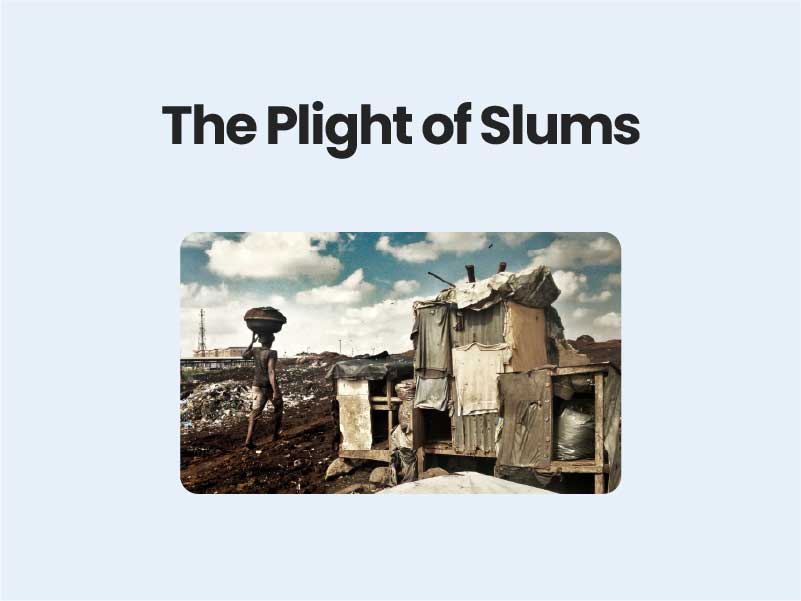Companion@360 → 7 Month programme to sharpen your writing skills → REGISTER NOW

The Plight of Slums
Eighty lakh children grow in India’s urban slums, and live a life of poverty, amid squalor and harsh living conditions. The slums and other informal settlements where about 49% of its population resides. This population, accounting for around 46 lakh people, lives in slums that occupy barely 7.5% of the city’s area according to Slum Rehabilitation Authority’s city survey data.
Slum:
- A large part of the country’s population lives in slums.
- Some slums are legally exiting, whereas the majority ones are illegally thriving in large pockets of the country.
- The magnitude of the problem can be gauged from the fact that nearly 3.5 crores of citizens of India live in slums and on pavements of metropolitan cities.
- one citizen out of every twenty five citizens is so afllicted. The slum dwellers are often denied electricity and sanitary facilities on the ground that their occupation is unauthorized.
- And quite often their huts are razed to the ground and they are evicted by the local authorities without offering them any alternative facility.The plight of these unfortunate evictees comprising women and children is indescribable.
- The condition of slum dwellers in all parts of the country faces similar apathy and situations, which is not too different from one another.
- 50-80% of employment is informal in developing cities, from street vendors to minibus drivers to migrant workers.
- More than 1 billion people live in slums and informal settlements globally.
- Between 152-216 million (17.4% of urban households) people in India live in dense informal housing, or slums.
- Highly populated urban residential areas consisting mostly of closely packed, decrepit housing units in a situation of deteriorated or incomplete infrastructure, inhabited primarily by impoverished persons.
- In Mumbai,While more than 70% of slum dwellers queued up for water delivered by tanker trucks every few days, the amount of water these households could access was far below the World Health Organization (WHO)’s recommendation of 50 liters per day in non-emergency situations
- World Resources Institute (WRI)’s World Resources Report documented how one slum in Bangalore is 12 times denser than the city average, housing 140,000 people per square kilometer.
Dharavi:
- One of Asia’s largest slums was a Covid-19 hotspot a few weeks ago but has under 100 active cases currently.
- While the number of infections seems to be in control at the moment the risk of spread continues to remain high within these neighborhoods where unusually high population densities – up to 350 families per hectare against the city average of 38 as per the 2011 Census.
- Poor drinking water and sanitation facilities mean that social distancing is virtually impossible.
Government initiatives:
- “Smart Cities Mission of 2015 proposed an investment allocation of Rs. 2,039 billion to convert 99 Indian cities into smart cities.
- Tamil Nadu Housing and Habitat Development Project to support innovations in housing finance and strengthen housing sector institutions in the state.
- Pradhan Mantri Awas Yojana – Urban.
- PURA Initiative
- Shyama Prasad Mukherji Rurban Mission (SPMRM)
- Affordable Housing( ‘jahan jhuggi, waha makan’ )
It is important to understand that the vision of a slum-free city needs to be viewed through the lens of inclusive development. Elimination and clearance of slums has to be substituted for up-gradation of living conditions, provision of access to basic services, and participation of the current slum dwellers in policy conception.
Read Also Redactive Pricing Audit

